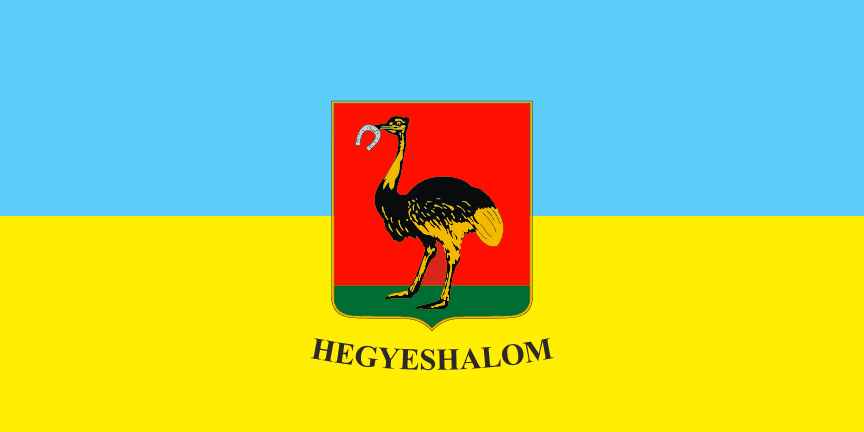 (1:2)
(1:2)image by Zoltan Horvath, 04 Febuary 2025

Last modified: 2025-02-07 by zoltán horváth
Keywords: hungary | gyor-moson-sopron | hegyeshalom |
Links: FOTW homepage |
search |
disclaimer and copyright |
write us |
mirrors
 (1:2)
(1:2)
image by Zoltan Horvath, 04 Febuary 2025
See also:
Hegyeshalom is a large village in Mosonmagyaróvár district of Győr-Moson-Sopron County, on the border with Austria and less than 15 km from the border with Slovakia.
Along the thousands of years old "royal road" it was important for the "imperium Romanum" and then for the peoples of the migration period and for the thousand-year-old Hungary.
The charter of Endre II from 1217 mentions it as Hegeshalm, a name referring to a hill with a peaked top.
The majority of the population was German, but the court nobles and craftsmen were Hungarians.
The destruction of the former population was a consequence of the Turkish retreat from Vienna in 1683.
The special history of the village began after the Treaty of Trianon in 1921. The settlement immediately became the most important border post in the country.
The settlement was soon classified as a large village.
Zoltan Horvath, 04 Febuary 2025
The flag of the settlement consists of two horizontal stripes of light blue and yellow. The shield of the coat of arms is placed in the center of the flag.
The name of the settlement is written under the shield in arc with black letters. The flag ratio is 1:2.
Images of flag:
https://marvin.bline.hu/product_images/721/0129004378110P.JPG
https://www.hegyeshalom.hu/gallery/2012.10.23/wgc_media/photos/hh9.jpg
https://opsz.hu/wp-content/uploads/2022/12/hegyeshalom1219-2.jpg
Zoltan Horvath, 04 Febuary 2025
gm-hh.gif)
image by Zoltan Horvath, 04 Febuary 2025
The coat of arms is a red shield, on which an ostrich holding a silver horseshoe in its beak can be seen on a green lawn.
The name of the settlement can be read on a blue and yellow ribbon below the shield.
The ostrich in the coat of arms, standing on the side of the road with a silver horseshoe in its beak, explains that the trade route between the West and the East led here,
and that is where 'Straus am Rhein' stands. This is where its German name 'Strassommerein' comes from, which the large village still uses today.
The settlement probably received the coat of arms as a gift from the Anjou kings (Charles Robert 1308-1342, Louis the Great 1342-1382).
The ostrich appears in their family coat of arms. (In the Middle Ages, it was a common custom for our kings to donate part of their coat of arms to cities and villages.
This is how Hegyeshalom got its hands on it.) The ostrich's natural history includes speed and alertness.
The Bible also knows about these qualities, and perhaps this is why the sacred bird, which reminded the members of the royal house of these two particularly valuable 'royal' qualities,
was included in the coat of arms of the royal house.
The ostrich symbolizes the royal qualities of speed and alertness. The silver horseshoe is a symbol of good fortune and luck.
Image of coat of arms:
https://www.hegyeshalom.hu/ (website of settlement)
Zoltan Horvath, 04 Febuary 2025